20 arrested in Tehran over bribery and influence-peddling at judiciary
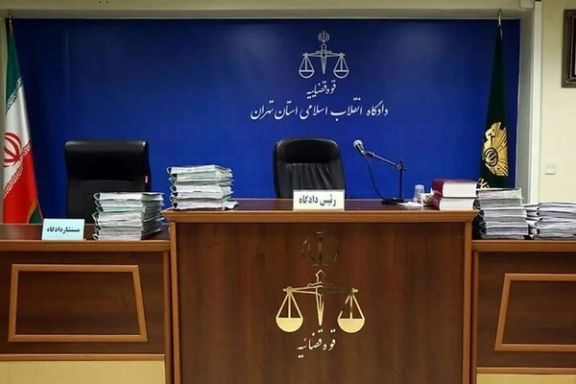
Iran has arrested 20 people in a crackdown on a suspected bribery and influence network operating within Tehran’s judiciary system, a top official said on Monday.

Iran has arrested 20 people in a crackdown on a suspected bribery and influence network operating within Tehran’s judiciary system, a top official said on Monday.
According to judiciary intelligence chief Ali Abdollahi, those detained include six judicial staff, five lawyers, four notaries, and five legal consultants and experts. The arrests were made in connection with activities at a major judicial complex in the capital.
Authorities seized a significant amount of gold coins, jewelry, and foreign currency during raids on properties linked to the group.
Abdollahi said the network was involved in “structured bribery, corruption, and manipulation of legal outcomes.” The investigation, he added, is part of broader efforts to root out internal corruption and restore public trust in Iran’s legal institutions.
No names have been released, and judiciary officials say the case is ongoing.
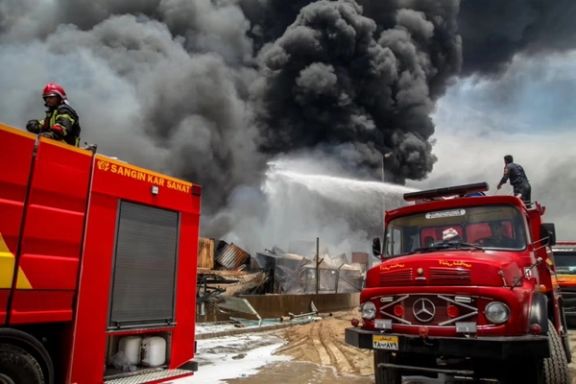
A senior Iranian lawmaker has raised the alarm over what he described as an abnormal and dangerous surge in fires and explosions at the country’s oil, gas, and petrochemical facilities, blaming Israel for at least some of the incidents.
“The pattern of fires this year in oil, gas, and petrochemical facilities is abnormal,” Mohammad Bahrami, a member of parliament’s energy committee, told the Iranian news outlet Didban Iran.
“Some of these incidents have occurred repeatedly and within short time intervals at sensitive complexes,” he added.
While Bahrami blamed aging equipment and lack of preventive maintenance as the key causes, he did not rule out possible sabotage operations by Israel.
“Around 50 percent of these incidents are caused by aging equipment, a lack of preventive maintenance, and outdated monitoring systems. About 30 percent stem from human error, insufficient training for operational staff, and failure to follow safety protocols," Bahrami said.
"The remaining 20 percent are a combination of managerial failures, delays in emergency response, weak HSE budgets, inadequate digital warning systems, and recent hostilities with the Zionist regime (of Israel),” he added.
A report by New York Times last month said Iranian officials increasingly suspect a coordinated campaign of sabotage may be behind the recent wave of unexplained fires and explosions across the country.
At least 12 major or mid-scale fires and explosions have occurred in oil and gas infrastructure during the first half of the current Iranian year which began in late March, according to estimates cited by Didban. The number exceeds 20 when minor fires and smoke-causing leaks are included.
Bahrami said the fires had led to deaths in incidents such as those at the Kharg petrochemical facility and Abadan refinery.
“Gas units have been taken offline for days, and both production and exports have been affected. Our international insurance and energy market reputation has suffered,” he said.
Bahrami warned that without structural reform and investments in digital safety infrastructure, Iran’s energy sector could suffer deeper reputational, financial, and operational damage.

The use of satellite internet system Starlink is growing in Iran amid mounting internet disruptions, as a new report criticizes officials for failing to deliver on pledges to improve connectivity.
“When such disruptions occur, the message to businesses is clear: the infrastructure cannot be trusted. That means instability—and it brings digital development to a halt,” said Pouya Pirhosseinlou, head of the Internet and Infrastructure Committee of the Tehran E-Commerce Association.
In late June, Iran’s parliament passed a law criminalizing the use or import of unauthorized communication tools such as Starlink with prison terms of six months to two years for people found using or importing such equipment without approval.
Anyone found importing more than 10 Starlink terminals “with intent to oppose the Islamic Republic” face five to 10 years in prison under the new statute.
Despite these prohibitions, the committee fifth internet quality report, released on Sunday, said that the use of Starlink satellite internet continues to rise.
The report placed Iran 97th out of 100 countries—ranking only above Cuba, Turkmenistan, and Sudan—detailing chronic slowness, frequent outages, and widespread blocking of services.
The damage from official filtering policies is structural and inescapable, Pirhosseinlou said.
“Even if we had America’s infrastructure, Iran’s internet would still be full of disruptions because of current filtering,” he added. “Filtering equipment is inherently disruptive. It causes serious malfunctions across many emerging protocols and websites.”
The Islamic Republic seeks to contain the growing appeal of Starlink, which offers users access to uncensored, high-speed internet beyond government control.
On June 23, amid the war with Israel, Iran’s Ministry of Communications submitted a formal complaint to the United Nations International Telecommunication Union (ITU), alleging Starlink was operating in Iran without a license.
The Revolutionary Guards-affiliated Fars News published a copy of the complaint, which followed Starlink’s activation inside Iran during widespread wartime internet shutdowns in June.
On June 14, one day into Israel's attacks on Iran, Starlink founder Elon Musk confirmed on X that “the beams are on,” signaling the service was operational as the country's internet went down in huge swathes of Iran.
Pirhosseinlou previously told ILNA that “over 30,000 unique users are utilizing satellite internet,” and the total number of users exceeds 100,000.
VPN use still expanding
However, the situation remains unreliable. “Many websites remain filtered, forcing user traffic through distant, inefficient routes and lowering speed,” Pirhosseinlou said.
“Our findings show that 93 percent of youth and 86 percent of the general public use VPNs. Even on unfiltered websites, users keep VPNs on—further degrading national internet performance.”
“Today, around 700,000 small businesses operate on Instagram. At least one million jobs are tied to that platform alone. Disruptions here directly hit people’s livelihoods.”
Government pledges remain unmet
Hamidreza Ahmadi, vice-chair of the committee, agreed, and criticized recent government promises to ease restrictions in a country where livelihoods depend on being connected.
Platforms like Instagram and Telegram remain central to Iran’s informal economy. “Based on survey data, 60 percent of people earning income from social media name those two platforms as their main sources of revenue," he said.
Continued instability risks compounding social and economic damage, he warned. “This situation threatens the capital—both social and financial—that has formed on these platforms.”
During June's 12-day war with Israel, the government imposed massive blackouts across the country, citing security concerns, but since the ceasefire, issues remain.
“On June 25, the minister said the internet had returned to its previous [pre-war] state. But technical data didn’t support this. Days after the ceasefire we see slight improvements—and serious technical issues still persist," Ahmadi added.
Pirhosseinlou directly challenged the president’s election campaign last year on internet freedom. “If the president has promised access to a free internet but cannot convince the Supreme Cyberspace Council to lift restrictions, then either he has to change the views—or he should resign.”
In October, rights watchdog Freedom House ranked Iran as having the world’s third most repressive internet environment.

A senior Iranian cleric whose family is at the center of a high-profile corruption investigation has stepped down from his role as Tehran’s interim Friday prayer leader, Iranian state media reported on Sunday.
Kazem Sedighi, a longtime ally of Supreme Leader Ali Khamenei, requested to be relieved of his duties in order to focus on academic and religious work. The request was approved by Khamenei, in line with Article 110 of Iran’s Constitution, which gives the Supreme Leader authority over key appointments.
Sedighi, a prominent religious figure often seen at the pulpit of Tehran University’s weekly Friday prayers, had held the post since 2009.
The move comes weeks after Sedighi’s son and daughter-in-law were arrested by the Revolutionary Guard’s Intelligence Organization in connection with an alleged land deal involving public property in northern Tehran.
The case, which has sparked widespread attention on Iranian social media, centers on the transfer of a 4,200-square-meter plot—valued at around $20 million—from a seminary founded by Sedighi to a company linked to his family.
According to documents leaked by Iranian journalist and whistleblower Yashar Soltani, the company was established in mid-2023 and included several close associates of Sedighi, including his daughter-in-law and a member of his personal security detail.
Sedighi initially denied the allegations, saying that he was unaware of the land transfer and alleged that his signature on the documents had been forged.
However, mounting public pressure and additional disclosures prompted him to issue a public apology and confirm the return of the land to the seminary.
Iran’s judiciary and the IRGC-affiliated Fars News Agency confirmed that Sedighi’s son and daughter-in-law were arrested in July. Authorities have said the case is under “careful and independent judicial review.”
While Sedighi has not been formally charged with wrongdoing, the episode has reignited public debate around accountability and corruption within Iran’s religious and political elite.
Friday Prayer Imams in Iran serve not only as religious leaders but also as political representatives of the Supreme Leader in their respective cities. There are more than 900 such figures across the country, many of whom hold influence over local institutions and business interests.
Sedighi, sometimes referred to by his critics as “the weeping sheikh” for his emotional sermons, has been a fixture of Iran’s clerical establishment for decades and was known for his outspoken loyalty to Khamenei.
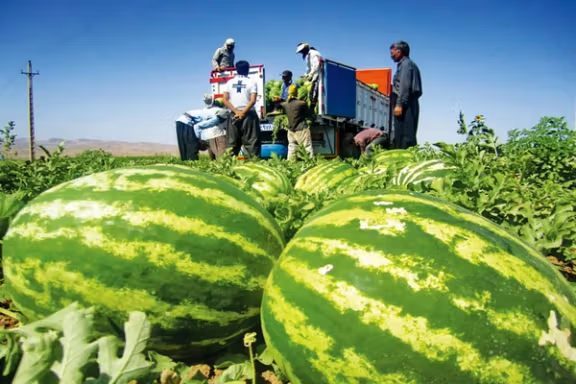
As Iran faces a deepening water crisis, a recent report by The Economist shows how the Islamic Republic is quietly flooding Persian Gulf markets with fruit and vegetables through a sprawling export scheme.
“The Islamic Republic… is in a serious pickle,” The Economist wrote in its Friday report.
Flooding the Persian Gulf with fruit and veg is one of its ways to pay for foreign goods it so desperately needs, added the outlet, saying “Iran now supplies nine out of ten cauliflowers, tomatoes and watermelons imported by the UAE.”
The trade relies on large state subsidies that make water, fertilizers and energy almost free.
Iran’s greenhouse cultivation has more than tripled in area since the early 2010s, supported by imported technology from countries including China and the Netherlands. Much of the equipment, The Economist wrote, originates from Israel—“a leader in the field”—though routed indirectly.
But this export boom is exacerbating water scarcity across Iran. With agriculture consuming over 90% of available water, and government support concentrated on export-focused farms, residents in cities like Tehran, Isfahan, Mashhad, and many others endure hours-long daily shutoffs. Officials have warned of a collapse of groundwater resources and irreversible environmental damage.

Across Iran, families are enduring days without running water. Many are stockpiling bottles, installing rooftop storage tanks, or relying on tanker deliveries—some of which provide unsafe supplies.
Satellite images obtained by Iran International show that Tehran’s main reservoirs—Amir Kabir, Lar, and Latyan—are at historic lows, holding less than 10% of their usable volume.
At the same time, the capital is physically sinking. Excessive extraction from depleted groundwater resources has caused sections of Tehran to subside by more than 25 centimeters per year.
Iran's produce in Sharjah port
The report by the Economist details how Iran’s produce reaches the UAE’s Sharjah port via small ships from Bandar Lengeh, south of the country.
From there, trailers carry shipments to Dubai’s Al Aweer market, the region’s largest wholesale food hub, where wholesalers blend Iranian goods with other imports or repackage them entirely.
Labels are swapped to hide origin—“We just put a sticker on the carton with a new origin: Azerbaijan, Turkey—anything but Iran,” one trader said.
The export trade operates through a parallel financial system. Formal banking channels are avoided due to US sanctions, so traders use the informal system to settle payments.
UAE-based middlemen collect dirhams from food buyers and channel them to Iranian exporters—often in exchange for vital machinery and appliances Tehran cannot otherwise import.
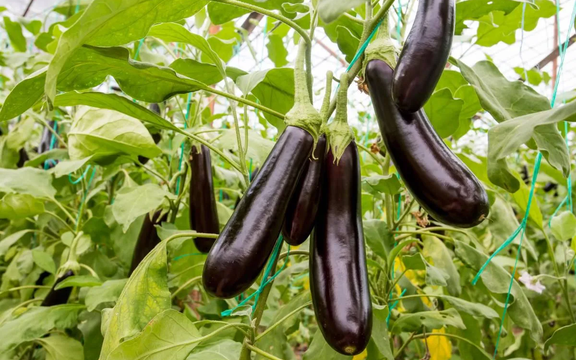
The Economist estimated the value of this clandestine export trade at $4bn to $5bn in 2024 alone.
Iran’s fruits often reach Persian Gulf supermarkets disguised and mispriced. Wholesalers inflate margins by mixing cheap Iranian tomatoes with Dutch imports and reselling the lot as premium goods.
“Instead of 4–5 dirhams, they sell the lot for 20–25 dirhams per kg,” said one insider. Some retail chains fly their staff business class and house them in luxury hotels—funded by “blended” produce profits, according to The Economist.
Despite occasional anti-dumping probes, Persian Gulf states appear to tolerate the flow. The report suggests some governments may see cheap Iranian food as a way to control inflation—or even preserve their own scarce groundwater by outsourcing farming to Iran.
But as water crisis deepens across Iran and key basins dry beyond recovery, Tehran’s strategy of exporting fruit may prove unsustainable. “However tempting,” The Economist warned, “bingeing on Iranian produce looks like a recipe for trouble.”
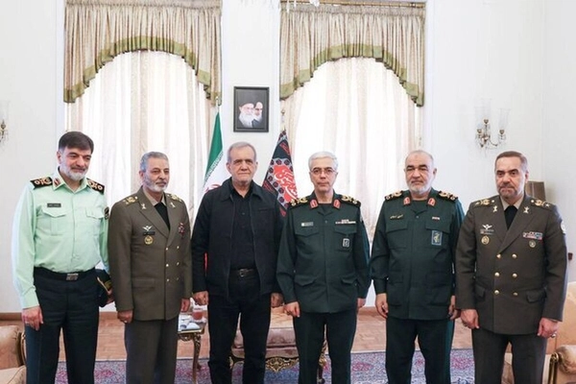
Iran’s president will head a newly revived Defense Council, a body composed of top military and security officials that played a key role in Iran's military decisions during the 1980s, a Revolutionary Guards-affiliated outlet reported on Saturday.
The council’s formation was reported a day earlier by state media as part of what they called structural reforms to the Supreme National Security Council (SNSC).
Tasnim News, which is close to the Islamic Revolutionary Guards Corps, said the body is intended to oversee national defense policies and streamline military decision-making.
The Defense Council already existed in the Islamic Republic's Constitution and is now being revived decades after it was active during the early years of the Iran-Iraq war in the 1980s, Mansour Haghighatpour, a politician close to Ali Khamenei's advisor Ali Larijani, told Eghtesad News on Saturday.
Tasnim wrote that the formation of the Defense Council has taken place within the framework of Article 176 of the Constitution of the Islamic Republic, which allows the SNSC to establish “subsidiary councils such as the Defense Council and the National Security Council” in accordance with its responsibilities.
"The Council's objectives appear to be supporting the comprehensive strengthening of the country’s defense capabilities, as well as accelerating and improving the efficiency of decision-making in the defense sector," the Tasnim report said.
The council’s members will include the judiciary chief, parliament speaker, commanders of the IRGC and the army, the intelligence minister, the chief of the armed forces general staff, the commander of the Khatam al-Anbiya Headquarters, and two Supreme Leader representatives at the SNSC, it added.
Fars News, another outlet linked to the Revolutionary Guards, said Friday the Defense Council is part of a wider reconfiguration of Iran’s security apparatus.
“With structural reforms in the Supreme National Security Council finalized, informed sources report the establishment of a new body called the ‘Defense Council’ — a strategic council tasked with overseeing national defense policies, whose structure is expected to be finalized soon,” it wrote.
The same report said Larijani is expected to be appointed as the new SNSC secretary, replacing Ali Akbar Ahmadian.
Larijani, a conservative heavyweight and close advisor to Supreme Leader Ali Khamenei, would be tasked with “forward-driving and strategic missions that require overarching coordination and management,” according to Fars.
'Saving Islamic Republic from collapse'
The revival of the Defense Council is a positive development, Haghighatpour said on Saturday, adding that it would transform the General Staff of the Armed Forces into a coordinating body rather than a commanding one.
“If we face serious conflict and our forces are to enter the field—considering that the army and the Guards constitute a combined force, with two air forces, two ground forces, and two navies—all engaging together requires a central command,” he added.
“Command must have a designated deputy, ensuring we are not caught off guard at critical moments.”
The Tasnim report said that “given the new security challenges and the complexity of regional and global threats, the revival of the Defense Council could lead to greater agility and focus in the country’s defense decision-making.”
Iran International's senior analyst Morad Vaisi believes the formation of the Defense Council is not meant to defend the people or the country but "to defend the Islamic Republic and prevent its collapse.”
“The surprise in the 12-day war has shaken Khamenei’s confidence in the military commanders, and he is now seeking to build more institutions above the IRGC, army, and the General Staff of the Armed Forces," Vaisi said.
During the conflict with Iran in June, Israel's air force took control of Iranian airspace, delivering a significant blow to the country's air defenses, while Iran's armed forces responded with successive waves of missile and drone attacks on Israeli territory.
Israeli military officials say that 120 air defense systems were destroyed or disabled since the first wave of attacks—around a third of Iran’s pre-war total. Long-range systems, including Russian-supplied S-300s and Iran’s Bavar-373 batteries, were among those targeted.